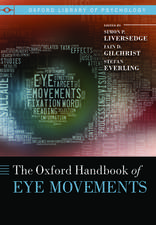Clinical Aspects of Sensory Motor Integration: Advances in Applied Neurological Sciences, cartea 4
Editat de Albrecht Struppler, Adolf Weindlen Limba Engleză Paperback – 17 noi 2011
Preț: 646.43 lei
Preț vechi: 760.50 lei
-15% Nou
Puncte Express: 970
Preț estimativ în valută:
123.69€ • 129.49$ • 102.35£
123.69€ • 129.49$ • 102.35£
Carte tipărită la comandă
Livrare economică 07-21 aprilie
Preluare comenzi: 021 569.72.76
Specificații
ISBN-13: 9783642715426
ISBN-10: 3642715427
Pagini: 368
Ilustrații: XI, 353 p.
Dimensiuni: 170 x 244 x 19 mm
Greutate: 0.59 kg
Ediția:Softcover reprint of the original 1st ed. 1987
Editura: Springer Berlin, Heidelberg
Colecția Springer
Seria Advances in Applied Neurological Sciences
Locul publicării:Berlin, Heidelberg, Germany
ISBN-10: 3642715427
Pagini: 368
Ilustrații: XI, 353 p.
Dimensiuni: 170 x 244 x 19 mm
Greutate: 0.59 kg
Ediția:Softcover reprint of the original 1st ed. 1987
Editura: Springer Berlin, Heidelberg
Colecția Springer
Seria Advances in Applied Neurological Sciences
Locul publicării:Berlin, Heidelberg, Germany
Public țintă
ResearchCuprins
I. Somatosensory Activity Relevant for Motor Output.- Tactile Afferent Input Influencing Motor Coordination During Precision Grip.- Neurophysiological Mechanisms Underlining Proprioceptive Sensations.- Noxious Cutaneous Input and the Tactile Exploratory Function of the Skin of the Hand.- New Aspects of the Role of Articular Receptors in Motor Control.- II. Central Motor Actions of Sensory Input.- Exteroceptive Input to the Motor Cortex in Man.- Reorganization of Projection from the Sensory Cortex to the Motor Cortex Following Deprivation of Thalamocortical Projection.- III. The Muscles and Their Neural Control.- Properties of Motoneurones and Motor Units in Relation to Problems of Sensorimotor Integration.- Activity of Motoneurons in Man under Stationary Conditions.- Automatic Sorting and Analysis of Multiunit EMG Recordings.- Functional Implications of Structure and Synaptology of Motor Neurons in Motor Neuron Disease.- Muscle Thixotropy and Its Effect on Spindle and Reflex Responses to Stretch.- Cytochemical Reevaluation of Location and Translocation of Acetylcholinesterase in the Motor End-Plate.- Control of Transmitter Release at Cholinergic and Glutamatergic Nerve Terminals.- Neurotrophism — Another Approach.- Persistent Depolarization of Muscle Fibers: A Common Cause of Weakness in Muscle Disorders.- IV. Convergence on the Final Common Path.- Ultrastructural Analysis of Target-Dependent Properties of Mammalian Motoneurones.- Ultrastructural Analysis of C-Type Synapses in Thoracic Motoneurones of the Cat.- Physiology and Pathophysiology of Reciprocal Inhibition in the Human Forearm.- V. Long-Loop Reflexes: Concepts and Consequences.- The Use of Short- and Long-Latency Reflex Testing in Leg Muscles of Neurological Patients.- Long-Latency Stretch Responses in Man— Segmental versus Suprasegmental Hypothesis.- Habituation of the Human Long-Latency Stretch Reflex and Its Cerebral Correlates.- Torque-Induced Stretch Responses — Changes Due to Hypotonia.- VI. Motor Functions of Basal Ganglia.- The Basal Ganglia and Sensorimotor Integration.- Facets of Akinesia in Parkinson’s Disease.- Immunohistochemical Studies on Neurotransmitters in Rat Basal Ganglia.- CNS Peptides in Huntington’s Chorea.- Neuropeptides in Central Movement Disorders of Man.- Analysis of Extrapyramidal Motor Symptoms from Stereoencephalotomy.- Stimulation for the Treatment of Motor Disorders.- VII. Thalamocortical Contributions to Sensory Motor Integration.- The Physiological Basis of VIM Thalamotomy for Involuntary Movement Disorders.- SEP and Muscle Responses Related to Thalamic (VL) and Subthalamic Structures in Man.- Electrical Stimulation in Human of the Sensory Thalamic Nuclei and Effects on Dyskinesias and Spasticity.- VIII. Posture and Movement: Interactions and Disturbances.- Multi-Joint Arm Posture — New Perspectives on the Control of Arm Posture.- Bimanual Load-Lifting Task. A Model for the Study of Coordination Between Posture and Movement.- Neuromotor Psychophysical Aspects of Central Programming and Peripheral Regulation of Movement in Humans.- IX. Effects of Growth, Degeneration and Regeneration on the Sensory Motor System.- Neurologically Effective Nerve Growths in the Mammalian Brain: Recent Work of Tsukahara and Kawaguchi.- What can Microneurography Tell the Clinician About Nerve Regeneration or Disease?.- Effects of Dopamine-Rich Grafts on Sensorimotor Impairments in Dopamine-Depleted Rats.




















